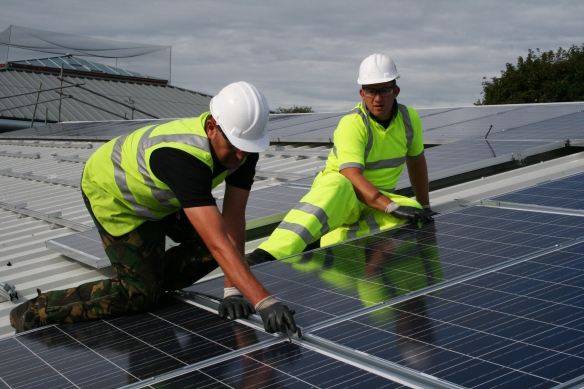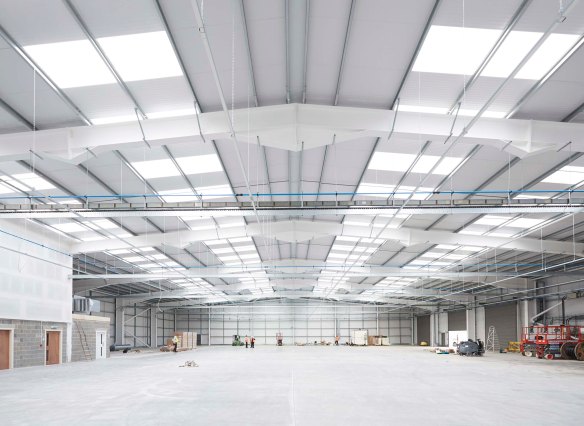One of the key outcomes COP 23, the UN Climate Change Conference, was the ‘Powering Past Coal Alliance’, led by the UK and Canada. According to the International Energy Agency, Coal-fired power plants produce almost 40% of global electricity, making carbon pollution from coal a leading contributor to climate change.
With more 20 countries in addition to numerous businesses and non-government partners on board, the new global coal alliance aims to phase out existing traditional coal power and freeze any new traditional coal power stations without operational carbon capture and storage. Commitments have also been made to focus on powering business operations without coal- something which many businesses here in the UK are already working towards.
In our last blog, we looked at how Hub 69, a 6,039 m2 warehouse and office space, was constructed by IM Properties to be their flagship Electricity Cost Neutral (ECN) building, and a template for future construction. Investment in renewable technology on this scale can be considerable, so what is the financial justification for such a step?
Whilst discussing why IMP were so keen to lead the market on sustainability and the innovative use of renewable technology, IMP’s UK Development Director, Kevin Ashfield, made the point that “there is a general trend of increasing utility costs, which affects the bottom line of occupiers. Our first ECN building provides a carbon-positive facility which will result in long term cost savings.” But how does this add up in reality?
COSTINGS
The Hub 69 has provided the basis for IMP’s ECN model. The model works on various educated assumptions, such as the typical hours of operation for the facility (which includes both warehouse and office spaces), and a standard supply contract from NPower (wherein the daytime rate is 10.623p and the night-time rate is 14.804p per kwh).
From this, IMP has estimated that the combined warehouse and office energy total annual consumption of 303,925 kWh. This equates to a cost per annum of £32,286 plus a £4,933 standing and capacity charge on 300 kVA, totalling £37,218.
Estimates suggest that the building will consume 90% of the energy it generates through its solar array (at times it will generate more energy that it needs and can store). This is 201,857 kwh of ‘free’ clean energy.
Remaining energy demand will then be drawn directly from the national grid. The estimated cost of this power (£15,775) is more than met through revenue generated from the FFR (Firm Frequency Response) service which is subsided by the National Grid (£11,669), and through TNUoS (Transmission Use of System charges, often known as TRIAD) (£7,124) and DUoS (Distributed Use of System charges) (£1,256). When weighed against the energy bill, this will result in a potential net revenue of £4,273. Additionally, there is the potential to export any surplus energy generated back to the grid to generate further revenue[1].
Fossil Fuels
But it’s not all about the money. The hidden costs using fossil-fuel power are well-documented. Air pollution, subsequent health implications, and of course the greenhouse emissions the burning of natural gas, oil and coal produce are all factors that need to be taken into consideration. As stated in the first blog in this series; we are at a tipping point if there is to be any chance of containing the rise in global warming and slowing climate change. Not to mention that the supplies are finite- once it’s gone, it’s gone.
The third and final step of the Trias Energetica model is to be efficient with our remaining supplies of fossil fuels. If we must draw upon them, we should ensure they are used as cleanly and sparingly as possible This, of course, will be easier if the first two steps have been followed to create a building constructed to the highest efficiency standards with integrated renewable technologies.
Futureproofing
Projects such as Hub 69 and IM Properties’ ECN Building Model illustrate the definite shift in attitude in the UK construction industry. Developers, architects, contractors and even building owners themselves are increasingly embracing the benefits of sustainable construction, applying its principles in innovative ways to create buildings which will future benefit both our pockets and our planet. And with the country’s engagement with initiatives such as the ‘Powering Past Coal Alliance’ and our commitment to the Paris Agreement, these measures may also protect against future legislative changes too.
As product manufacturers, Kingspan is aware of its responsibility to this cause. As the market continues to expand, it is up to us as market leaders to not only pioneer new technologies with energy conservation at their heart, but to educate the industry on the issues underlying the necessity. Which, we hope, this series of blogs has begun to do.


 Whilst there are some who dispute the truth of climate change, over 90% of scientists agree that it is caused by us
Whilst there are some who dispute the truth of climate change, over 90% of scientists agree that it is caused by us
 These days few people can take advantage of ‘the great outdoors’ as often as maybe they would like to. This is typically due to commitments that result in as much 90% of their time being spent under the harsh glare of poor electric lighting. The main issue of this lifestyle is the effect on mental health and productivity. But, with summer fast approaching, there is no better time to think about the benefits of bringing good lighting to indoor spaces. So, how do we create these sufficient levels of natural light inside?
These days few people can take advantage of ‘the great outdoors’ as often as maybe they would like to. This is typically due to commitments that result in as much 90% of their time being spent under the harsh glare of poor electric lighting. The main issue of this lifestyle is the effect on mental health and productivity. But, with summer fast approaching, there is no better time to think about the benefits of bringing good lighting to indoor spaces. So, how do we create these sufficient levels of natural light inside?